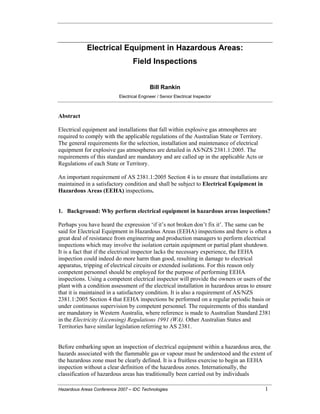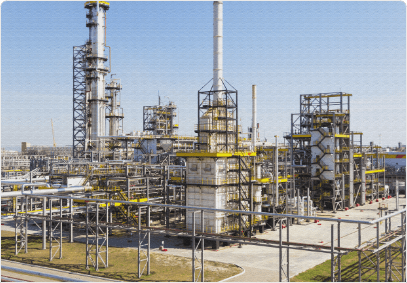Roar Solutions Things To Know Before You Get This
Wiki Article
The smart Trick of Roar Solutions That Nobody is Discussing
Table of ContentsGetting My Roar Solutions To WorkThe Of Roar SolutionsThe smart Trick of Roar Solutions That Nobody is Discussing
In order to secure setups from a potential surge an approach of evaluating and identifying a potentially harmful location is required. The objective of this is to make sure the correct choice and installation of tools to ultimately protect against a surge and to make sure safety and security of life.
(https://pagespeed.web.dev/analysis/https-training-roarsolution-com-au/mm9wy036rp?form_factor=mobile)
No equipment ought to be set up where the surface temperature of the equipment is above the ignition temperature level of the provided danger. Below are some usual dust harmful and their minimal ignition temperature. Coal Dust 380C 225C Polythene 420C (thaws) Methyl Cellulose 420C 320C Starch 460C 435C Flour 490C 340C Sugar 490C 460C Grain Dirt 510C 300C Phenolic Material 530C > 450C Aluminium 590C > 450C PVC 700C > 450C Residue 810C 570C The probability of the threat being present in a concentration high enough to trigger an ignition will certainly differ from area to location.
In order to categorize this risk an installment is divided into locations of risk relying on the amount of time the unsafe exists. These locations are described as Areas. For gases and vapours and dirts and fibers there are three zones. Zone 0 Area 20 A hazardous ambience is highly most likely to be existing and may be existing for extended periods of time (> 1000 hours annually) and even continually Zone 1 Area 21 A dangerous atmosphere is feasible but unlikely to be existing for extended periods of time (> 10 450 C [842 F] A classification of T6 implies the minimum ignition temperature is > 85 C [185 F] Harmful location electric devices maybe designed for usage in higher ambient temperatures. This would indicated on the ranking plate e.g. EExe II C T3 Ta + 60C( This means at 60C ambient T3 will not be surpassed) T1 T1, T2, T3, T4, T5, T6 T2 T2, T3, T4, T5, T6 T3 T3, T4, T5, T6 T4 T4, T5, T6 T5 T5, T6 T6 T6 A T Class rating of T1 means the optimum surface temperature generated by the tool at 40 C is 450 C. Thinking the connected T Class and Temperature level score for the equipment are ideal for the area, you can always utilize an instrument with a much more rigorous Division rating than required for the area. There isn't a clear response to this question unfortunately. It really does rely on the kind of devices and what repair services require to be carried out. Equipment with certain examination treatments that can not be executed in the area in order to achieve/maintain 3rd party ranking. Should come back to the manufacturing facility if it is prior to the equipment's service. Field Repair Work By Authorised Personnel: Complicated screening might not be called for however certain procedures might need to be adhered to in order for the devices to keep its 3rd event ranking. Authorized workers should be employed to execute the work correctly Fixing should be a like for like replacement. New element have to be thought about as a direct replacement needing no unique screening of the devices after the repair is total. Each tool with a harmful score should be reviewed individually. These are outlined at a high level listed below, but for more comprehensive details, please refer directly to the guidelines.
The Single Strategy To Use For Roar Solutions
The equipment register is a comprehensive data source of devices records that consists of a minimum collection of fields to determine each item's area, technological specifications, Ex lover category, age, and environmental data. The ratio of Detailed to Close examinations will be determined by the Tools Danger, which is analyzed based on ignition threat (the probability of a source of ignition versus the probability of a flammable atmosphere )and the unsafe location category( Zone 0, 1, or 2). Applying a durable Risk-Based Evaluation( RBI )technique is important for making sure conformity and safety and security in taking care of Electric Tools in Hazardous Locations( EEHA).
How Roar Solutions can Save You Time, Stress, and Money.

In regards to explosive risk, a dangerous area is a setting in which an explosive atmosphere is present (or might be anticipated to be present) in quantities that need special precautions for the building, setup and use equipment. hazardous area course. In this article we discover the obstacles dealt with in the workplace, the danger control actions, and the required competencies to function safely
It is an effect of modern life that we produce, store or deal with a series of gases or fluids that are considered flammable, and a variety of dusts that are regarded combustible. These materials Clicking Here can, in particular problems, form explosive ambiences and these can have significant and terrible effects. A lot of us recognize with the fire triangular get rid of any kind of among the 3 elements and the fire can not occur, however what does this mean in the context of harmful locations? When breaking this down right into its most basic terms it is basically: a combination of a certain quantity of release or leak of a particular material or material, blending with ambient oxygen, and the presence of a resource of ignition.
In the majority of circumstances, we can do little concerning the levels of oxygen in the air, but we can have considerable impact on sources of ignition, for instance electric devices. Dangerous areas are recorded on the unsafe area category illustration and are determined on-site by the triangular "EX" sign. Here, amongst various other crucial info, areas are divided into three kinds depending on the risk, the likelihood and period that an eruptive atmosphere will exist; Area 0 or 20 is considered one of the most dangerous and Zone 2 or 22 is deemed the least.
Report this wiki page